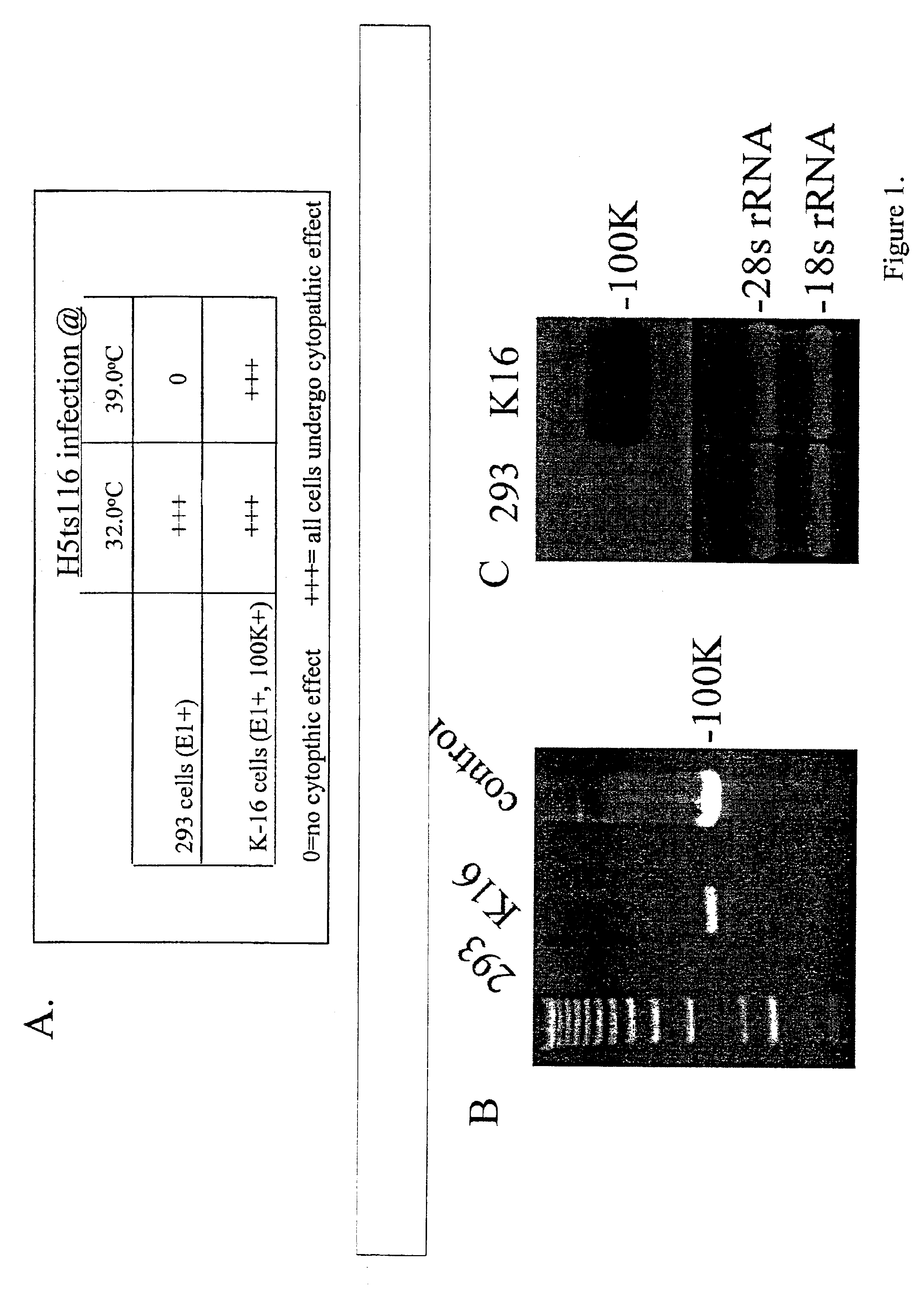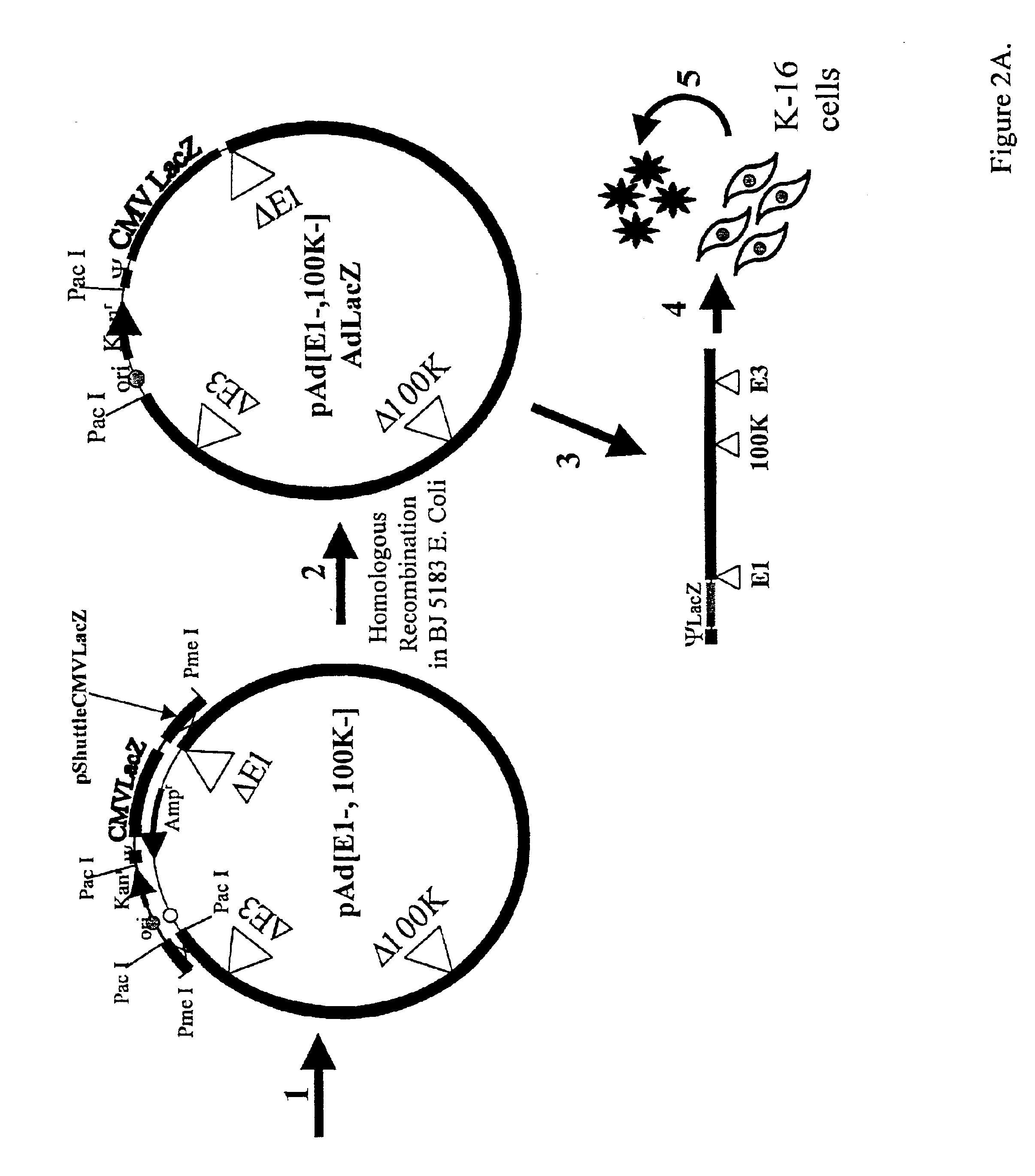Replicating adenovirus vectors
a technology of vectors and adenoviruses, applied in the field of replicating adenovirus vectors, can solve the problems of limiting the benefit/risk ratio of [e1a+,e1b]ad based cancer therapies, low level, etc., and achieves similar levels of gene expression, amplify transgene expression, and high transgene expression
- Summary
- Abstract
- Description
- Claims
- Application Information
AI Technical Summary
Benefits of technology
Problems solved by technology
Method used
Image
Examples
example 1
Cell Lines
Production of E1 and 100K Expressing Cell Lines:
[0161]Ad5 derived DNA was used as a template for the PCR amplification of the 100K open reading frame (ORF) using an EcoRI tailed forward primer:[0162]5′-CGGAATTCGATCATGGAGTCAGTCGAG-3′ (SEQ ID NO:1)
and an XbaI tailed reverse primer:[0163]5′-GCCTCTAGAGTCCCATCTACGGTTGGG-3′ (SEQ ID NO:2)
[0164]100 ng of each primer were included in a reaction mixture containing 10 mM KCl, 10 mM(NH4)2SO4, 20 mM Tris-Cl (pH=8.75), 2 mM MgSO4, 0.1% Triton X-100, 0.1 mg / ml bovine serum albumin, 25 mM of each dNTP, 2.5 units of a high fidelity Taq polymerase (Stratagene, La Jolla, Calif.) and 100 ng of Ad5 genomic DNA. After denaturation for 3 minutes at 95° C., the reaction mixture was subjected to a limited number of PCR amplification cycles consisting of DNA denaturation at 95° C. for 30 seconds, primer annealing at 55° C. for 45 seconds, and Taq mediated extension at 72° C. for 1.5 minutes. This same PCR reaction was utilized to screen genomic DNA...
example 2
Replication Assays
[0168]The indicated cell lines were infected at a multiplicity of infection (MOI) of 5 with the respective vectors, incubated for 2 or 20 hours at 37° C., and total DNA was harvested. Ten micrograms of each sample were digested with EcoRV, electrophoresed through a 0.7% agarose gel, and the vector DNA visualized after ethidium bromide staining.
example 3
One Step, Limited Burst Assay
[0169]Indicated cell lines were infected at the indicated MOI's with the respective vectors, and total virus yield was measured by X-gal staining of C-7 cells infected with serial dilutions of the vector containing lysates, as previously described (Amalfitano et al., 1998) J. Virology 72:926).
PUM
| Property | Measurement | Unit |
|---|---|---|
| temperatures | aaaaa | aaaaa |
| temperatures | aaaaa | aaaaa |
| temperature | aaaaa | aaaaa |
Abstract
Description
Claims
Application Information
 Login to View More
Login to View More - R&D
- Intellectual Property
- Life Sciences
- Materials
- Tech Scout
- Unparalleled Data Quality
- Higher Quality Content
- 60% Fewer Hallucinations
Browse by: Latest US Patents, China's latest patents, Technical Efficacy Thesaurus, Application Domain, Technology Topic, Popular Technical Reports.
© 2025 PatSnap. All rights reserved.Legal|Privacy policy|Modern Slavery Act Transparency Statement|Sitemap|About US| Contact US: help@patsnap.com



